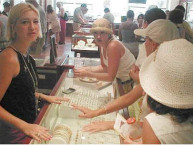Emerald
![]()
Emerald continues to be the most popular gemstone throughout the islands.  With the mines of Colombia and Brazil being located right next to the Caribbean region, emeralds are brought to the island jewelry stores direct from the mining and cutting centers of South America.
With the mines of Colombia and Brazil being located right next to the Caribbean region, emeralds are brought to the island jewelry stores direct from the mining and cutting centers of South America.
The finest Emeralds come from the top three Colombian mines: Muzo, Chivor, and Cosquez. Emeralds of varying (but generally inferior) color, clarity, and quality are also mined in Brazil, Pakistan, Afghanistan, Madagascar, Nigeria, Russia, Zambia, and Zimbabwe.
Emeralds from the Muzo mine are a deep green with a trace of yellow or blue. Emeralds from the Quipama mine are a little bit on the yellowish side. Emeralds from the Coscuez mine have a hint of blue and are of a rich intense color. Chivor Emeralds are known for their bluish tones, they are still blue/green, but they have a lot of blue for an Emerald. If this is appealing to you and you love the unique, this is one to see.
Inclusions not only give each Emerald character it also can help determine exactly which mine the Emerald originated from. A two phase tubular inclusion is characteristic of Chivor stones. The parasitic crystal only appears in stones from the Muzo mine. Common to all Colombian Emeralds is the three phase inclusion, comprised of Solid, Liquid & Gas. Spiral inclusions are also indicative of Colombian Emeralds.
When shopping for emeralds there are several points that you should keep in mind.
1. All emeralds  will have some type of inclusions, no matter how small. The very nature of the coloration of the beryl crystal with chromium or vanadium imparts inclusions in the crystal/ This is also why you should never turn down an emerald of nice color simply because of some inclusions. Because of the relatively low specific gravity of emeralds (SGE = 2.72), emeralds are physically larger than similarly weighted diamonds or rubies.
will have some type of inclusions, no matter how small. The very nature of the coloration of the beryl crystal with chromium or vanadium imparts inclusions in the crystal/ This is also why you should never turn down an emerald of nice color simply because of some inclusions. Because of the relatively low specific gravity of emeralds (SGE = 2.72), emeralds are physically larger than similarly weighted diamonds or rubies.
2. Emeralds are like opals in that he stones are quite porous and will often have small fissures and gas bubbles exposed during the cutting process. As a result, just like opals, emeralds are coated with a clear resin-like oil that helps to seal the stone from detergents, hand lotions, etc. from seeping into the stone during everyday wear. As long as this oiling is done using a clear oil the process is acceptable and virtually every emerald is treated in this manner. However, if a green colored oil is used to hide inclusions and enhance the color, this process must be disclosed to you at the time of sale.
3. Emeralds are rare. Very rare. And no one needs to discount emerald jewelry because of this rarity. If you see emeralds being offered at big discounts you should be very cautious.
Don’t be too strict on proportioning when shopping for emeralds. These stones are very rare and they are cut to save the most amount of the original crystal. Since color is the most important factor with emeralds, be prepared to see some off shapes.
Finally, most U.S. jewelers do not work with enough emeralds to be able to appraise a fine Colombian emerald. Most cannot identify a chromium or vanadium coloring element in the stones which has a great effect on the price of the stone. If you need a proper appraisal please call the CGI.
or vanadium coloring element in the stones which has a great effect on the price of the stone. If you need a proper appraisal please call the CGI.
Caring for emeralds. Emeralds should be cleaned with warm water, a very mild detergent, and a soft brush. Ultrasonic or steam cleaning is not safe and can result in breakage or inadvertent release of oils (which mask inclusions). Emeralds should be re-oiled every 2-5 years and reset only by jewelers experienced with the special handling requirements of these gems. Loose stones should be stored in velvet-lined boxes within individual compartments. They should be stored separately from diamonds and other harder gems to prevent scratching.
Emeralds role in History:
Emeralds have captivated the imagination since the beginning of time. Early man believed they were magic and held curative powers. They were also believed to be able to heighten fertility and sexual desire in females. As a result of such claims, Emeralds were greatly sought after and a profitable trade was established between Egypt and nations as far away as India
Egypt was one of the earliest sources of emeralds. The Cleopatra mines supplied fine Emeralds from 330 BC until 1235 AD. These mines were mostly underground, utilizing slave labor in desert heat.
Venus was said to have been able to detect the infidelity of her lovers if her emerald changed colors. Emeralds were a favorite gem of Cleopatra, her lovers soon learned that a gift to her of Emerald jewelry was a good thing. Emperor Nero also enjoyed Emeralds for their calming affect.
In the Jewish tradition, we are told that God gave King Solomon four precious stones, one of which was an Emerald. The four are said to depict mastery over creation, symbolized by the four cardinal points.
A 78 carat Emerald discovered in Europe once belonged to a Mongol Emperor. Written in Persian on the stone were these words, “He who possesses this charm shall enjoy the special protection of God.”
The Spanish were amazed to discover the Inca Indians virtually worshipped the Emerald. One King of the Incas possessed a large ostrich egg sized Emerald that his subjects would sacrifice other smaller Emeralds to for good fortune. The devotion the Incans felt towards the Emeralds was so great that many of them died rather than to divulge the location of the sacred Emerald mines.
In 1558 the Spaniards located a mine at Muzo, near Columbia. They enslaved the Indians of that region to mine for the precious Emeralds. These gems were then shipped back to Spain and Europe, finding their way into the collections of the Royal Families of Europe and Asia. The Ottoman Turks, the Persian Shahs and even the royalty of India were featuring delicately sculpted emeralds as the showpieces of their jewel collections.
Cort�s sent emeralds from Mexico to the Spanish court. One of these was reported to be shaped like a pyramid and as broad as the palm of the hand. The object disappeared en route to Spain.
One Inca tribe was said to have hidden away vast amounts of large Emeralds in an undisclosed location. So true were they to their religious beliefs that not one divulged the location, most were killed or thrown into slavery. That huge fortune of Emeralds remains hidden to this very day.
The fruit those early Incan mines is still evident today. Christies of London held a sale of rare East Indian artwork on September 27, 2001. A feature of the sale was one of the largest Emeralds in the world which dates back to the Mogul dynasty of India.  The 217.80 ct. rectangular cut Emerald is elegantly inscribed with an Islamic prayer and a date that translates to 1695 A.D. Carved on the reverse side are a rosette flanked by poppy flowers and foliate detail. It is the only known carved and dated emerald of the Mogul period. It was purchased via auction for $2,200,000 by an undisclosed bidder.
The 217.80 ct. rectangular cut Emerald is elegantly inscribed with an Islamic prayer and a date that translates to 1695 A.D. Carved on the reverse side are a rosette flanked by poppy flowers and foliate detail. It is the only known carved and dated emerald of the Mogul period. It was purchased via auction for $2,200,000 by an undisclosed bidder.
This Emerald most likely was mined in South America by Indian slave labor and sent to India by the Spanish. The size and quality match those of that date from this area.
The Hudson Museum at the University of Maine may have the oldest known emerald and the only known Pre-columbian carved emerald. The emerald green gem was carved into the shape of a standing figure. It is 2.2 inches tall and weighs 118.5 carats.
The stone was given to the university by alumnus William P. Palmer, III in 1982. An index card which came with the artifact states:
“Emerald figure of a man. To the best of my knowledge the only Emerald carved in the round piece in existence [sic] of Pre-columbian origin. Area unknown, 500 B.C. to 250 A.D.”
The piece was purchased or delivered March 30, 1968 from a New York City dealer. The University performed a battery of nondestructive tests to determine whether or not the stone was an emerald or a synthetic.
The overall appearance and color of the stone are consistent with a natural emerald rather than an epoxy fake. The stone’s refractive index, the ratio between the velocity of light passing through a vacuum and light passing through emerald, is within the range of natural emerald. When the stone is viewed through a Chelsea filter, which absorbs most visible light but transmits the long red wavelengths and a band in the yellow-green portion of the spectrum, a definite reddish area appears, consistent with natural emerald from Colombia.



